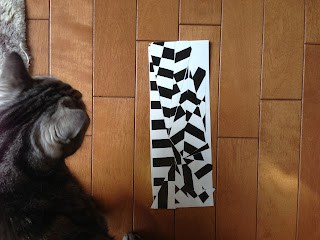I have been trying to find just the right carrier for some basic art supplies, but haven't been able to find one, so I thought I'd put one together.
Supplies:
An old book (¥100 at a used book store)
Glue stick(s), white glue, scissors, craft scissors, craft knife/box cutter, strong string, ruler, magnets, thin steel sheeting for art projects, decorations (paint, washi tape, etc.)
Glue the pages of the book together around the edges. Careful with this, especially in corners, as it will be difficult to cut sharp corners later. Don't glue the back or front pages to the cover yet.
Being VERRRRRRY careful, start cutting the inside section of the pages. Use the ruler to mark off the width around the edges. This book happened to have a border outlined (in white), so I just followed that. I think I made the borders too wide, though. I think the book would be strong enough with slightly narrower borders.
Half-way through. Now for the final pages:
Time to start cutting the steel sheet. You'll need a pair of craft scissors for this. I'd also recommend a pair of work gloves - probably leather. It is SO easy to cut yourself on the metal.
Measure the inside of the book and cut out two sheets. Set them aside.
Take a piece of cord, leather strip, or something else that will be sturdy with wear. Make two holes in the back of the book on the right in the middle. I was going to use metal eyes, but thought it might make the steel sheet lift off too high from the back cover when it was glued. I think the holes will be fine.
Run the cord through the holes, put a brad in the middle of the front cover, and leave enough space for the cord to wrap around it. Close the book and tie the cord so that it keeps the book closed but is still easy to open:
Back inside the book, using white glue, glue one metal sheet to the back inside cover and the last page of the book:
Add the sheet to the inside front cover:
The edges of the sheet are extremely sharp, so cover them with washi tape or some other tape that will protect you if you happen to touch these edges:
Paint the outside pages of the book in your favorite color (gold, etc.), and start adding the things you'll be using in your carrying case. Here, I found a watercolor set that came in a plastic case like a CD cover. I turned it inside out, washi-taped the pieces back-to-back, put a strip of magnetic tape on the back, and put pens in the "pocket" of the case. There's also a magnetic strip on the bottom of the case so it stands up and it's easy to see the sizes of the pens:
I found some little plastic cases and put magnetic strips on the backs. They hold things like washi paper, erasers, pencil sharpener, crayon, etc. The Frisk box, magnetic strip on back, holds 7 Stabilo point 88 (fine 0.4) markers. The metal sheet on the inside front cover can hold your favorite quotes, stencils, etc., held in place with magnets.
This was a first try so that I could make mistakes. I had fun and learned from it, so even if I don't use the book a lot, I'll have that experience under my belt the next time I make one of these.
* = * = * = * = * = * = * = * = *














































